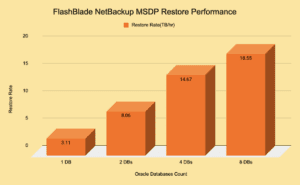Restore is one of the biggest challenges in data protection. If you have legacy data protection architecture, it can take days to recover your backup data in the event of a disaster or ransomware attack. For each hour of downtime, your business could lose thousands of dollars.
Storage products like Pure Storage® FlashBlade® help solve the problem of slow restore. FlashBlade integration with Veritas NetBackup MSDP can help make things a lot less stressful for backup admins whenever there’s a need for data recovery at rapid speed.
In this post, we’ll look at the performance numbers observed on backup and restore tests of Oracle databases with NetBackup MSDP and FlashBlade NFS and see how FlashBlade solves the shortcomings of restore capabilities.
How FlashBlade Solves the Restore Challenge of Data Protection
Data has evolved in the modern era, and as result, data protection requirements have too. Businesses are truly protected when they can keep up with demanding service-level agreements (SLAs) and rapidly recover from any unexpected events. Modern protection enables data reuse—by rapidly restoring data—to support the General Data Protection Regulations (GDPR) and analytics initiatives. FlashBlade’s architecture and storage systems meet growing needs for compact, high-performing, reliable, simple-to-own-and-operate, petabyte-scale storage, primarily optimized for unstructured data. A FlashBlade system can host multiple file systems and a multi-tenant object store at the same time, and make both available to thousands of users. The architecture is specifically designed for flash media, rather than for mechanical disks, whose characteristics are not suitable for high-speed metadata access.
The key property of FlashBlade is the flexibility to increase performance, capacity, and connectivity simultaneously, without disrupting access or diminishing performance or data integrity. Functionality can be added as well, as your requirements and underlying technologies evolve over anticipated system lifetimes of a decade or more of uninterrupted service.
NetBackup MSDP for Oracle Backup and Restore
Long recognized as the market-share leader of enterprise backup and recovery software, Veritas NetBackup protects the largest and most demanding multi-cloud and data center environments. NetBackup provides breakthrough capabilities for virtualized and cloud-based deployments. Features like high performance, intelligent automation, and centralized management based on a flexible, multi-tier architecture enable NetBackup to adapt to the growing needs of a fast-paced, modern enterprise.
A key feature of NetBackup is its deduplication technology. Benefits of NetBackup deduplication include improved storage efficiency and a reduction of bandwidth consumption and backup window, which results in cost optimization. Pure Storage has partnered with Veritas to enable its deduplication technology of FlashBlade NFS.
Performance Evaluation
Test Strategy
We conducted comprehensive tests to back up and restore Oracle databases to validate and showcase the performance of FlashBlade. For tests
involving backup and recovery of deduplicated data to and from FlashBlade, we created eight volumes on FlashBlade and exported them to a single media server. The volumes were then NFS mounted on the single media server using eight different mount-points and virtual IP addresses. These volumes were presented to NetBackup as a single media server deduplication pool (MSDP), and the second NetBackup physical host was used for hash compute only. While you can add more than one media server for hash compute purposes, there’s only one data path to FlashBlade NFS which is from the MSDP storage media server. We created several Oracle databases with different datasets of 1TB in size to determine the throughput when backing up and restoring one, two, four, and eight databases.

The test environment
Backup Performance
We used Veritas NetBackup to perform a series of full backups of the Oracle databases by varying the number of databases from one, two, four, and eight. To simulate this test in the real world, after the very first level zero (full) backup, we introduced 5% of the change in the database prior to the next level one (incremental) backup. Oracle’s internal view (v$rman_backup_job_details) captures the backup speed, and hence, shows the end-to-end backup timing and not just the time spent at NetBackup and FlashBlade. Based on our environment setup, in which each database host is limited to 10Gbps, the backup rates were linear with two, four, and eight databases.
Rapid Restore of Oracle
In this test environment, we also did a full restore of the Oracle database(s) through NetBackup from FlashBlade to demonstrate the rapid restore capability. We performed a series of full restores of the Oracle databases through NetBackup by varying the number of databases from one, two, four, and eight. As with the backup test, Oracle’s internal view (v$session_longops) captures the restore speed, and thus shows the end-to-end restore timing and not just the time spent at FlashBlade and NetBackup.

Performance of Oracle databases (Full and full with 5% data change)
Restore Performance
The restore tests show the biggest advantage of FlashBlade—rapid restore. The test results for restore rates climbed as high as 18.5TB/hr. In further testing, the restore rates went up to 22.5TB/hr when we added an additional media server, along with the media servers shown in the reference architecture for hash compute. As you can see in the chart below, the restore rates scale really well from 1DB to 8DBs. These rates are far superior to any other data protection solutions and only possible when you use a FlashBlade as the backend storage target for data backup.

Key Takeaways
To recap, by deploying FlashBlade with NetBackup MSDP, we achieved superior restore performance with linear performance growth when moving from one database to eight databases. We solved one of the biggest challenges of data protection—“Rapid Restore”—and attained ultra-fast backup with near-linear performance growth. Storage efficiency and data reduction rates improved with NetBackup MSDP in place, as well as compression from both NetBackup and FlashBlade.
See how you can put NetBackup MSDP and FlashBlade to work for you. For complete details on the solution implementation, check out the “Rapid Restore of Oracle Using FlashBlade and NetBackup” technical white paper.

ANALYST REPORT, 14 PAGES






